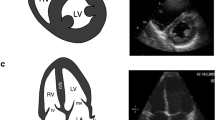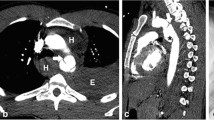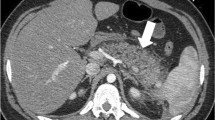Abstract
Background
Treatment of patients with concomitant pelvic arterial hemorrhage and blunt abdominal trauma (BAT) is challenging. Controversies remain over the diagnostic approach and the priority of available treatment resources.
Methods
Between 1999 and 2008, 545 patients were admitted due to concomitant BAT and pelvic fracture. Seventy-six patients receiving both angiography and laparotomy were studied. Focused abdominal sonography for trauma (FAST) was used as the primary triage tool in the early 5 years and multi-detector computed tomography (MDCT) in the later 5 years. The clinical courses and results were retrospectively analyzed to determine if the evolution of the clinical pathways for managing these patients resulted in improved outcomes.
Results
Performing laparotomy solely based on FAST during the early 5 years resulted in a high nontherapeutic laparotomy rate (36%). Contrast enhanced MDCT, as the primary triage tool, accurately disclosed active intra-abdominal and pelvic injuries and was helpful in promptly tailoring the subsequent treatment. Additional surgical trauma was avoided in some patients and nontherapeutic laparotomy rate decreased to 16%. Multiple bleeders were found in 70% of positive angiograms; bilateral internal iliac artery embolization for the purpose of damage control showed a lower repeat angioembolization rate for these severely injured patients.
Conclusion
The revised clinical algorithm served well for guiding the treatment pathway. Priority of laparotomy or angiography should be individualized and customized according to the clinical evaluation and CT findings. Angiography can be both diagnostic and therapeutic and simultaneously treat multiple bleeders; thus, it has a higher priority than laparotomy. The primary benefits of our later clinical pathway were in reducing nontherapeutic laparotomy and repeat angioembolization rates.

Similar content being viewed by others
References
Demetriades D, Karaiskakis M, Toutouzas K et al (2002) Pelvic fractures: epidemiology and predictors of associated abdominal injuries and outcomes. J Am Coll Surg 195:1–10
Grotz MR, Gummerson NW, Gansslen A et al (2006) Staged management and outcome of combined pelvic and liver trauma—an international experience of the deadly duo. Injury 37:642–651
Biffl WL, Smith WR, Moore EE et al (2001) Evolution of a multidisciplinary clinical pathway for the management of unstable patients with pelvic fractures. Ann Surg 233:843–850
Heetveld MJ, Harris I, Schlaphoff G et al (2004) Hemodynamically unstable pelvic fractures: recent care and new guidelines. World J Surg 28:904–909
Davis JW, Moore FA, McIntyre RC Jr et al (2008) Western trauma association critical decisions in trauma: management of pelvic fracture with hemodynamic instability. J Trauma 65:1012–1015
Bassam D, Cephas GA, Ferguson KA et al (1998) A protocol for the initial management of unstable pelvic fracture. Am Surg 64:862–867
Eastridge BJ, Starr A, Minei JP et al (2002) The importance of fracture pattern in guiding therapeutic decision-making in patients with hemorrhagic shock and pelvic ring disruptions. J Trauma 53:446–451
Durkin A, Sagi HC, Durham R et al (2006) Contemporary management of pelvic fractures. Am J Surg 192:211–223
Gansslen A, Giannoudis P, Pape HC (2003) Hemorrhage in pelvic fracture: who needs angiography? Curr Opin Crit Care 9:515–523
Osborn PM, Smith WR, Moore EE et al (2009) Direct retroperitoneal pelvic packing versus pelvic angiography: a comparison of two management protocols for hemodynamically unstable pelvic fractures. Injury 40:54–60
Verbeek D, Sugrue M, Balogh Z et al (2008) Acute management of hemodynamically unstable pelvic trauma patients: time for a change? Multicenter review of recent practice. World J Surg 32:1874–1882
Foley WD (2002) Special focus session: multidetector CT: abdominal visceral imaging. Radiographics 22:701–719
Dondelinger RF, Trotteur G, Ghaye B et al (2002) Traumatic injuries: radiological hemostatic intervention at admission. Eur Radiol 12:979–993
Fang JF, Wong YC, Lin BC et al (2006) Usefulness of multidetector computed tomography for the initial assessment of blunt abdominal trauma patients. World J Surg 20:176–182
Velmahos GC, Toutouzas KG, Vassiliu P et al (2002) A prospective study on the safety and efficacy of angiographic embolization for pelvic and visceral injuries. J Trauma 52:303–308
Margolies MN, Ring EJ, Waltman AC et al (1972) Arteriography in the management of hemorrhage from pelvic fractures. N Engl J Med 287:317–321
Miller PR, Moore PS, Mansell E et al (2003) External fixation or arteriogram in bleeding pelvic fracture: initial therapy guided by markers of arterial hemorrhage. J Trauma 54:437–443
Agolini SF, Shah K, Jaffe J et al (1997) Arterial embolization is a rapid and effective technique for controlling pelvic fracture hemorrhage. J Trauma 43:395–399
Bryceland JK, Keating JF (2008) Laparotomy and unstable pelvic fractures. Injury 39:853–857
Hagiwara A, Minakawa K, Fukushima H et al (2003) Predictors of death in patients with life-threatening pelvic hemorrhage after successful transcatheter arterial embolization. J Trauma 55:696–703
American College of Surgeons Committee on Trauma (1997) Advanced trauma life support, 6th edn
Fang JF, Shih LY, Wong YC et al (2009) Repeat transcatheter arterial embolization for the management of recurrent pelvic arterial hemorrhage. J Trauma 66:429–435
Stengel D, Bauwens K, Rademacher G et al (2005) Association between compliance with methodological standards of diagnostic research and reported test accuracy: meta-analysis of focused assessment of US for trauma. Radiology 236:102–111
Becker A, Lin G, McKenney MG et al (2010) Is the FAST exam reliable in severely injured patients? Injury 41:479–483
Friese RS, Malekzadeh S, Shafi S et al (2007) Abdominal ultrasound is an unreliable modality for the detection of hemoperitoneum in patients with pelvic fracture. J Trauma 63:97–102
Shanmuganathan K, Mirvis SE, Sherbourne CD et al (1999) Hemoperitoneum as the sole indicator of abdominal visceral injuries: a potential limitation of screening abdominal US for trauma. Radiology 212:423–430
Bansal V, Fortlage D, Lee J et al (2009) Hemorrhage is more prevalent than brain injury in early trauma deaths: the golden six hours. Eur J Trauma Emerg Surg 35:26–30
Soreide K, Krüger AJ, Vårdal AL et al (2007) Epidemiology and contemporary patterns of trauma death: changing place, similar place, old faces. World J Surg 31:2092–2103
Huber-Wagner S, Lefering R, Qvick LM et al (2009) Effect of whole-body CT during trauma resuscitation on survival: a retrospective, multicentre study. Lancet 373:1455–1461
Shapiro M, McDonald AA, Knight D et al (2005) The role of repeat angiography in the management of pelvic fractures. J Trauma 58:227–231
Gourlay D, Hoffer E, Routt M et al (2005) Pelvic angiography for recurrent traumatic pelvic arterial hemorrhage. J Trauma 59:1168–1174
Conflicts of interest
None.
Author information
Authors and Affiliations
Corresponding author
Rights and permissions
About this article
Cite this article
Fang, JF., Shih, LY., Wong, YC. et al. Angioembolization and laparotomy for patients with concomitant pelvic arterial hemorrhage and blunt abdominal trauma. Langenbecks Arch Surg 396, 243–250 (2011). https://doi.org/10.1007/s00423-010-0728-9
Received:
Accepted:
Published:
Issue Date:
DOI: https://doi.org/10.1007/s00423-010-0728-9




